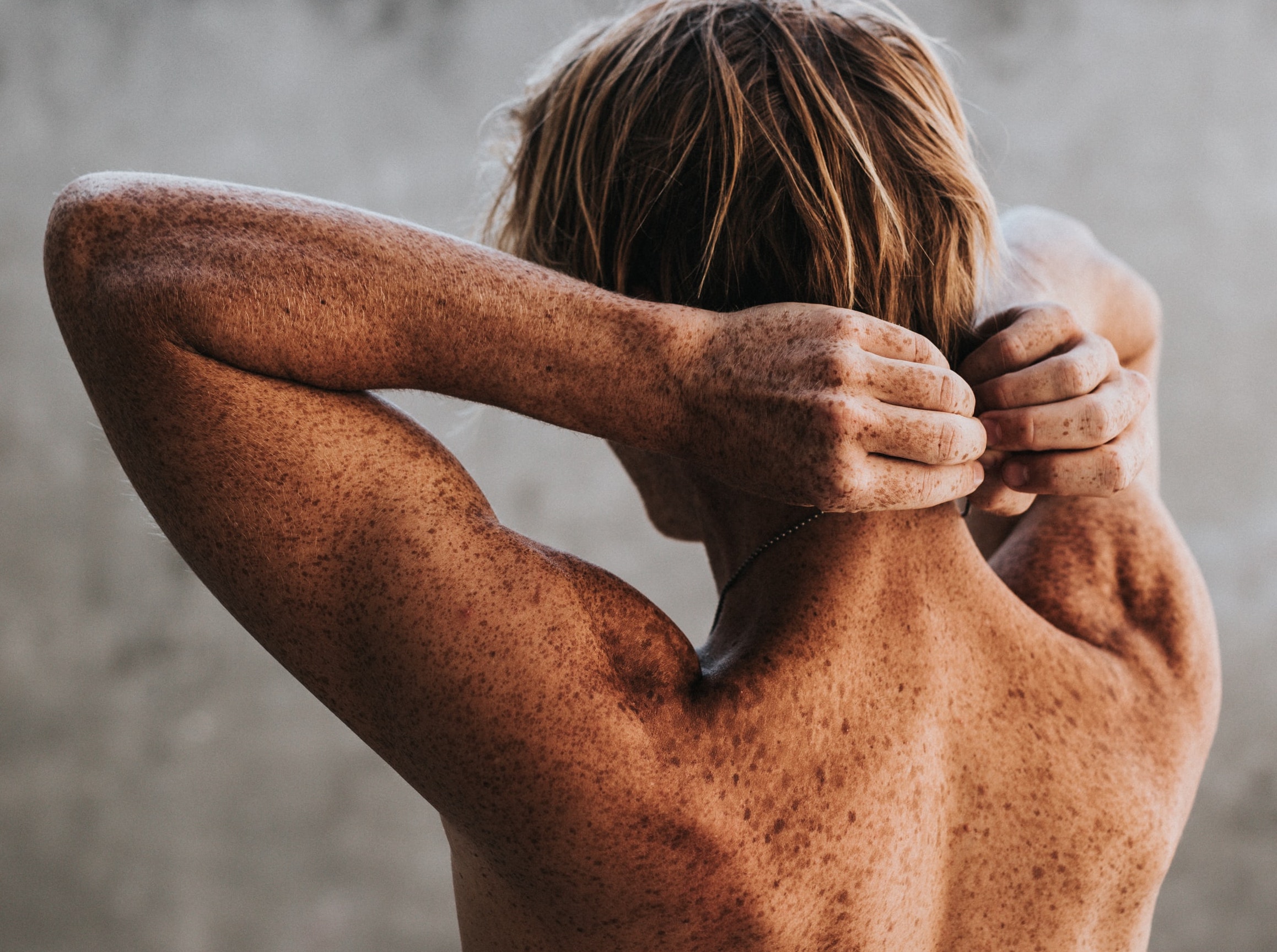Bumps or lumps under your skin are usually harmless, but if you suspect you have a cyst it’s worth having a medical professional take a look. They can help you diagnose the type of cyst, the risks, the potential causes, and your options for cyst removal.
The most common cause of cyst formation is blockages of fluid, tissue, hair, or dead skin. But they can also result from infections, genetic disease, or inflammation. You must know what type of cyst you’re dealing with to manage it effectively.
Cyst Identification
You should always have a medical professional identify your cyst. They are better equipped to recognize the different types and their potential risks. However, you can use this cyst identification guide as a reference while you wait for your appointment or consultation.
Baker’s (Popliteal) Cyst
Location: A baker’s cyst appears at the back of the knee. It can cause pain or discomfort, particularly when bending or extending the knee or if the cyst ruptures.
Appearance: This cyst is a fluid-filled blockage that presents itself as swelling. Proper identification may require an MRI or ultrasound.
Formation: The popliteal cyst is often the result of excess synovial fluid (a liquid found in the knee joint). The excess fluid is forced to the back of the knee where it builds and forms a baker’s cyst.
Branchial Cleft
Location: A branchial cleft cyst presents itself on one or both sides of the neck, the upper shoulder, or the collarbone.
Appearance: Typically, the branchial cleft looks like a lump. They can cause tenderness, swelling, and may exhibit fluid drainage. Early symptoms include dimpling and skin tags.
Formation: This cyst is the result of a congenital birth defect. It occurs where tissues fail to form properly during embryonic development. Inflammation is most common during an infection, and doctors may drain fluid and/or prescribe antibiotics.
Chalazia
Location: A chalazia cyst forms on the upper or lower eyelid.
Appearance: This cyst usually appears as swelling or a small lump. Although normally painless, an infection can cause pain, excess swelling, or redness. If there is enough swelling it can even impede vision.
Formation: Meibomian glands produce oils that help moisten the eyes. When these oils become trapped, a chalazion cyst can form. Inflammation or a virus affecting this region increases the likelihood of these cysts forming. As well, blepharitis, rosacea, and acne can play a role.
Although these cysts can go away on their own, it’s is best to treat one professionally if there is an infection.
Epidermoid Cyst
Location: Epidermoid cysts can form anywhere on the skin, especially in areas where hair grows. They are especially common around the face, neck, and abdomen.
Appearance: These are usually identified as small, round bumps. There may be a darker bump visible under the skin, and if infected they can be red and tender. Squeezing one can cause a white discharge, similar to that from popping a zit.
Formation: An epidermoid cyst is the result of keratin protein buildup. It typically occurs as a result of trauma around a hair follicle. The outer layer of the skin begins to grow deeper instead of outward, leading to a cyst.
A genetic disorder, Gardner’s syndrome, is another possible cause of epidermoid cysts, although it is rare.
Ganglion Cyst
Location: Ganglion cysts typically form along a tendon close to joints. Wrists and hands are the most common sites, although they can occur on the feet and ankles as well.
Appearance: These cosmetic skin lesions are round, fluid-filled bumps. They can be up to an inch in diameter or too small for the naked eye to see. Pain, tingling, numbness, or limited mobility can occur around the affected joint.
Formation: Fluid accumulation, caused by injury or overuse, is the best-known cause of ganglion cyst formation. Although ganglion cysts are not usually dangerous, they can be limiting in some movements that can affect your hobbies or career, and in rare cases can be symptoms of cancer.
Ingrown Hair Cyst
Location: An ingrown hair cyst can happen anywhere your body grows hair. They are most likely to form in areas you shave or wax, such as the face, neck, armpits, and/or legs.
Appearance: The first appearance of an ingrown hair cyst is usually a small reddish bump. The trapped hair may even be visible. If the cyst progresses it can become red, white or yellow, and the surrounding area may become red and irritated.
Formation: This cyst forms when a hair grows into the skin, instead of outwards. The fluid becomes trapped with the hair and forms the bump. It is often the result of minor trauma to hair follicles such as shaving, waxing, or chafing.
Usually, this type of growth goes away on its own without medical intervention. Although infections may require a professional.
Mucous Cyst
Location: Mucous cysts (mucocele) occur on the lips or around the mouth.
Appearance: Typically painless, a mucocele appears as a fluid-filled swelling.
Formation: Trauma to the mouths salivary glands can cause them to be clogged with mucous. Typical causes of this include ruptures, lip biting, or poor dental hygiene. Although these usually go away on their own, visit a doctor if they are recurring frequently as they can be symptomatic of other issues.
As well, if a mucous cyst doesn’t disappear you may require a plastic surgeon to stop it from becoming permanent.
Pilar Cyst
Location: Pilar, or trichilemmal, cysts almost always occur on the scalp, although they can form anywhere on the body.
Appearance: Most people experience multiple pilar cysts at the same time. They are flesh-coloured bumps with a firm, smooth texture. They’re often identified around the size of a quarter, although they continue to grow slowly if untreated.
Formation: Genetics appear to play a role in the development of pilar cysts, with a 50% chance of the trait being passed on to one’s children. These cysts are the result of a keratin buildup in hair follicle linings.
Pilonidal Cyst
Location: Pilonidal cysts occur at the upper-middle of the buttocks, near the tailbone.
Appearance: This condition first presents itself as a depression on the skin. Once it becomes infected it can become a fluid-filled cyst or pus-filled abscess. It can be painful, and the draining fluid or pus may emit an unpleasant odour.
Formation: Pilonidal cysts are most common among men, especially those who spend a lot of time sitting. Skin, oils, hair, or other debris becomes trapped under the skin, leading to a cyst once if infected.
Ovarian Cyst
Location: These cysts form on the ovaries. It can occur on one or both.
Appearance: Due to their location, ovarian cysts cannot be seen without medical imaging tools. Instead, they may present themselves as symptoms such as:
- Abdominal bloating
- Pelvic pain during/before the menstrual cycle
- Nausea and/or vomiting
- Lower back pain
Formation: Follicular ovarian cysts occur when a follicle grows larger than normal during a menstrual cycle. These are the most common type of ovarian cysts. They can occur at any point in a woman’s life even during pregnancy or after menopause.
Sebaceous Cyst
Location: Sebaceous cysts tend to present themselves on the face, ears, neck, upper arms, chest, or back. They can occur anywhere on the body with the exception of the soles of the feet or palms of the hands.
Appearance: These cysts are soft bumps that grow under a thin layer of skin. They are slow-growing and sometimes have a visible hole on them.
Formation: The sebaceous glands produce oil (sebum) for skin and hair. When the glands rupture or experience blockage, cysts begin to form and fill with sebum.
Newmarket Cyst Removal
If you want to remove a cyst safely and effectively, you need an expert cosmetic surgeon. At the Plastic Surgery Skin Clinic in Newmarket, our plastic surgeons assess your cysts and recommend an effective treatment plan.
There are always steps you can take to feel better. Contact us today to set up an appointment to go over your options in detail.

